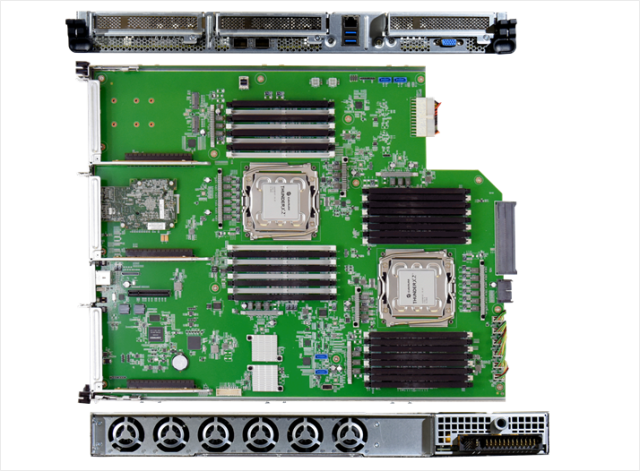
At the Open Compute Summit in Santa Clara, California, today, Microsoft showed off the latest iterations of Project Olympus, its open source data center server design. Until now, the servers in Microsoft's data centers have all used Intel x86 processors, but now both of those elements—"Intel" and "x86"—have new competition.
In news that's both surprising and unsurprising, Microsoft demonstrated Windows Server running on ARM processors. Qualcomm and Cavium have both designed motherboards for the Project Olympus form factor that use ARM chips: Qualcomm's Centriq 2400 processor, a 10nm 48 core part, and Cavium's ThunderX2 ARMv8-A, with up to 54 cores. In addition to offering lots of cores, both are highly integrated systems-on-chips with PCIe, SATA, and tens of gigabits of Ethernet all integrated.
Microsoft isn't yet letting third parties use these systems. The Windows Server build is an internal build, and Microsoft is using the systems in those applications where it says they make the most sense, with the company listing search and indexing, storage, databases, big data, and machine learning as workloads that benefit from the high throughput the ARM systems offer.
More broadly, the company says that ARM is appealing because it has greater scope for extending the instruction set. The 64-bit ARM instruction set is (relatively) clean and neatly designed, making it easier to integrate new capabilities and extensions. How true this is in practice is less clear, especially as customized, extended ARM designs jeopardize another desirable ARM trait: a large extant software and developer base that is familiar with the platform.

On the one hand, porting Windows Server to ARM is not tremendously surprising; we know that Windows client is coming back to ARM (indeed, although Microsoft stopped selling Windows client systems with ARM processors in 2015, Windows on ARM never actually went away, as Microsoft continued to develop it for use in Internet-of-Things devices). Given that Microsoft has largely consolidated Windows into a single common platform, cranking out a Server build for ARM should have been relatively straightforward.
As ARM has made a push for the server room, industry observers have long anticipated a build of Windows Server for ARM to ensure that Windows does not get left behind in this space. With credible ARM hardware on the cusp of widespread availability, it makes sense for Microsoft to go public.
But on the other hand, Microsoft has never been very successful with Windows built for anything other than x86 processors, so much so that "Wintel"—Windows on Intel—became synonymous with the PC platform. There are reasons to believe that Windows Server on ARM will be more successful than Windows on Itanium, PowerPC, Alpha, and MIPS, because ARM, unlike all those other non-x86 (and, except for Itanium, non-Intel) processor families, has massive industry support and designs that are at least somewhat competitive across a wide range of workloads, but success and widespread adoption is no certainty.
And Microsoft certainly has plenty of other options. ARM systems weren't the only Project Olympus hardware to be shown off. Microsoft has been working with AMD and has designs using the company's forthcoming Naples processor, a 32 core, 64 thread system-on-chip with enormous I/O bandwidth from its 128 PCIe lanes, built around AMD's new Zen core.
And industry stalwart Intel isn't sitting on its hands, either. Project Olympus servers using Skylake chips were also on display. Skylake-EP, the server version of Skylake, isn't available to buy yet, but Google announced in late February that it was already using the chips for its cloud services as part of a partnership with Intel. Skylake-EP is not merely a bigger version of the desktop chips with more cores, more cache, and more processor sockets; it also adds AVX-512, an extension of the existing AVX instruction set that enlarges it to operate on 512 bit data types, up from 256 in desktop Skylake. This makes Skylake-EP even stronger at a wide range of number-crunching workloads and highlights one of the ways in which Intel might differentiate its chips from Naples: Skylake-EP with AVX-512 will likely boast four times the floating point performance than Naples at the same clock speed.
reader comments
73